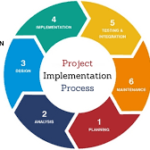In today’s rapidly evolving business environment, project control is more important than ever. This function ensures projects are completed on time, within budget, and meet specified quality. While project controlling is not a new practice, the introduction of smart project management with risk control has revolutionized the field. This article aims to shed light on smart project-controlling techniques, especially those related to risk management.

Traditional Vs. Smart Project Controlling
Traditional Methods
Traditional project-controlling methods often consist of manual tracking via spreadsheets, Gantt charts, or basic project management software. While useful, these methods have their limits. They can be labor-intensive, prone to human error, and may not provide real-time insights.
Smart Methods
Smart project controlling integrates technology such as artificial intelligence, machine learning, and data analytics to improve efficiency and effectiveness. This smart approach allows for real-time tracking, predictive analytics, and flexibility to adapt as situations change.
Importance of Risk Management in Smart Project Controlling
Identifying Risks Early
Risk management in smart project controlling is a cornerstone. Using smart tools, project managers can identify and address potential risks at an early stage. The sooner a risk is detected, the easier it is to mitigate its impact, thereby contributing to successful project completion.
Quantifying Risks
Advanced analytics can quantify risks, thereby enhancing decision-making processes. Risk quantification is essential for effective resource allocation and contingency planning. Smart project controlling with risk mitigation provides a solid framework for evaluating and managing risks in real time.

Techniques in Smart Project Controlling
Data Analytics
One of the significant advantages of smart project control is the use of data analytics. These analytics tools can predict potential delays, cost overruns, and even quality issues, providing valuable insights into risk management strategies for smart project control.
Automation
Automation of routine tasks, such as data gathering and reporting, can free up valuable time for the project manager. This time can then be focused on complex tasks that require human expertise, including risk assessment. Smart project controlling with risk assessment techniques provides managers with a nuanced understanding of the various risk factors that may affect the project.
Cloud Computing
Cloud computing has emerged as a fundamental tool in smart project controlling. With cloud technology, team members can access project data and analytics from anywhere, thereby improving collaboration and enhancing risk management efforts.
Case Studies
Company A
Company A implemented smart project controlling methods and saw a 20% reduction in project completion time. The company made extensive use of risk management strategies for smart project controlling, including predictive analytics and real-time monitoring.
Company B
Company B, focusing on risk management in smart project controlling, was able to identify potential risks early and avoid significant financial losses. Their risk management strategies, combined with smart project-controlling techniques, led to the successful completion of multiple projects under budget.
Conclusion
Smart project controlling is more than just a buzzword; it’s an effective approach that leverages technology to improve traditional project management methods. With an emphasis on risk management, including risk mitigation and risk assessment, smart project controlling allows for better decision-making, ultimately contributing to successful project outcomes.


